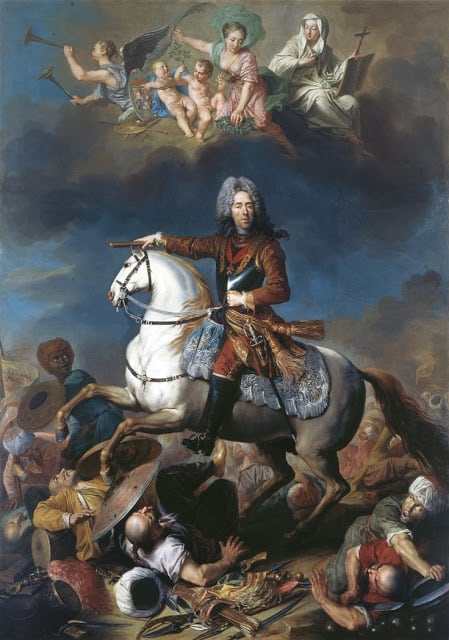No, nic proti, ale tahle bitva určitě nepředstavovala "první velký střet mezi Habsburky a Osmanskou říší". Co třeba předchozí dvojí obléhání Vídně, nebo bitvy u St. Gotthardu a u Zenty...? 
5.8. 1716 Battle of Petrovaradin
Categories: Years of war and revolution , Calendar

It represented the first major clash between the Habsburgs and the Ottoman Empire. Prince Eugene of Savoy won. He was helped by artillery support from the Petrovaradin fortress, but also by a timely counterattack by the cavalry.
On July 23, the Turks began to cross the Sava and advance on Petrovaradin. Prince Eugene of Savoy transferred most of his troops across the Danube River and took up a position in front of the Petrovaradin fortress in the trenches and fortifications that had been preserved there from previous battles. The soldiers repaired and improved the fortifications in a feverish haste, and waited with growing anxiety for the enemy to appear on the horizon.
Two Tartars, who had been captured by a cavalry patrol on August 2, told that the Turkish main body was laid to rest two hours' march from Karlovac and would reach Petrovaradin the next day. The Grand Vizier Damad Ali was confident of victory. "I feel that I am a better warrior than Prince Eugene," he boasted to his generals.
But the Turkish avalanche did not frighten the commander-in-chief of the imperial troops. He ordered Count Palffy to go forward with a cavalry detachment of three and a half thousand men to reconnoitre the battle and to ascertain the strength and direction of the enemy's advance. Near Karlovac, Pálffy's cuirassiers, dragoons and hussars encountered a Turkish vanguard of 20,000 men. For four hours they bravely fought off the furious attacks of the Spahis. Four hundred of them fell," writes Karel Richter in his book Eugene of Savoy: Lord of the Battleships.
Count Siegfried von Bräuner and a group of cuirassiers were breaking out of a tight grip when a horse fell beneath him. One of the cuirassiers immediately jumped down from the saddle and offered his horse to the commander. The next moment he fell under the blow of a Turkish sabre. Count von Bräuner jumped on his horse, but he was not able to extricate himself from the dense mixture of Turkish blades and hands, which grasped at him until he was thrown to the ground. With his hands bound and a rope round his neck, all bloodied, he was dragged into the Grand Vizier's tent.
Damad Ali wanted to behead him immediately, but then changed his mind. The Austrian general is a valuable prize. So he ordered him to be kept in chains. On the fourth of August, the prince summoned the commanders of all battalions, squadrons and artillery batteries to a war council. Damad Ali is about to wage a decisive battle using his crushing nature. Prince Eugene decides to surprise him by not waiting for him to strike and attacking first.
"On the night of the 4th to the 5th. August, the imperial army of over fifty thousand infantry and twenty-seven thousand cavalry with eighty guns crossed the Danube by boat bridges inthe bend of the river and took up a defensive position fortified by hastily digging trenches and building fortified firing positions. Meanwhile, the Grand Vizier's troops had spread out on the slopes of the heights opposite Petrovaradin," Richter writes.
In the end, Prince Eugene of Savoy prevailed. He was helped by artillery support from the Petrovaradin fortress, but also by a timely counter-attack by the cavalry. The Turkish army gave way and Damad Ali was mortally wounded, dying shortly after the battle.
Sources.
The article is included in categories:



